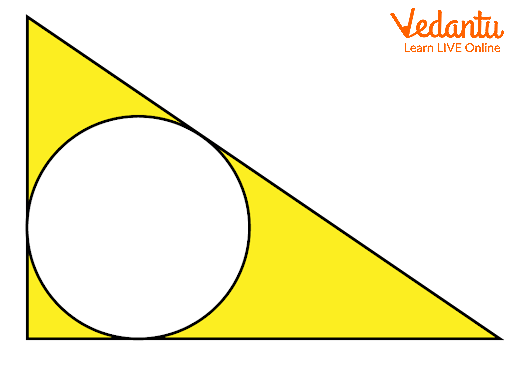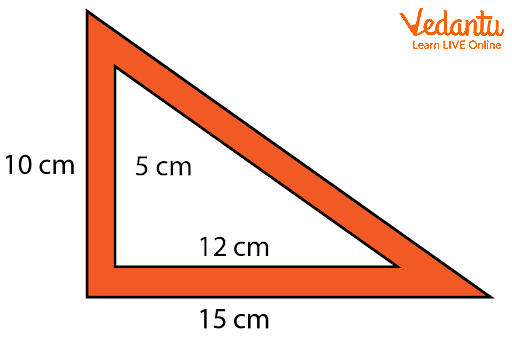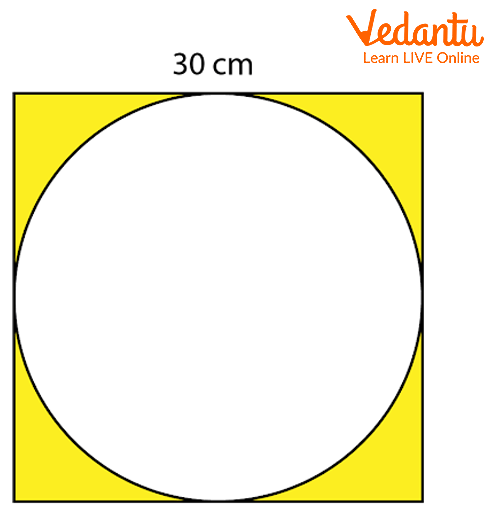




Introduction
The area of the shaded region is basically the difference between the area of the complete figure and the area of the unshaded region. For finding the area of the figures, we generally use the basic formulas of the area of that particular figure. There is no specific formula to find the area of the shaded region of a figure as the amount of the shaded part may vary from question to question for the same geometric figure.
What is Area ?
Area is basically the amount of space occupied by a figure. The unit of area is generally square units; it may be square meters or square centimeters and so on.
Formula for Area of Geometric Figures :
Area of a square \[ = \] side \[ \times \] side
Area of a triangle \[ = \dfrac{1}{2} \times \] base \[ \times \] height
Area of a circle \[ = \] \[\pi {{\rm{r}}^2}\]
Area of a parallelogram \[ = \] base \[ \times \] height
Area of a trapezium \[ = \dfrac{1}{2}\] \[ \times \]sum of the length of the parallel sides \[ \times \] height
Area of rhombus \[ = \dfrac{1}{2}\] \[ \times \] product of the diagonals
What is the Area of the Shaded Region ?
In a given geometric figure if some part of the figure is coloured or shaded, then the area of that part of figure is said to be the area of the shaded region.

Example on how to Find Area of the Shaded Region
How to Find the Area of the Shaded Region?
So, the area of the shaded or coloured region in a figure is equal to the difference between the area of the entire figure and the area of the part that is not coloured or not shaded.
Area of the shaded region \[ = \] Area of the complete figure \[ - \] Area of the unshaded part
In the above image, if we are asked to find the area of the shaded region; we will calculate the area of the outer right angled triangle and then subtract the area of the circle from it. The remaining value which we get will be the area of the shaded region.
Solved Examples :
1. Find the area of the shaded region from the given figure :

Area of the Shaded Region
Solution :
Here, the length of the given rectangle is 48 cm and the breadth is 22 cm.
We can observe that the outer rectangle has a semicircle inside it. From the figure we can observe that the diameter of the semicircle and breadth of the rectangle are common.
So from this figure we can understand that the area of the shaded region for this figure will be equal to the difference between the area of the outer rectangle and the area of the inner semicircle.
We know that, Area of rectangle = length \[ \times \] breadth
∴ Area of the given rectangle = 48 cm \[ \times \] 22 cm \[ = 1056\] sq.cm
Also, Area of a semicircle = \[\dfrac{1}{2}\pi {r^2}\]
Here, diameter \[ = 22\] cm
So, Radius \[ = \dfrac{1}{2} \times \] Diameter \[ = \dfrac{1}{2} \times 22 = 11\]cm
Area of the given semicircle \[ = \dfrac{1}{2} \times \dfrac{{22}}{7} \times 11 \times 11 = \dfrac{{2662}}{{14}} = 190.14\]sq.cm
Therefore, Area of the shaded region = Area of rectangle - Area of semicircle
So, Area of the shaded region in the given figure = 1056 - 190.14 = 865.86 sq.cm
Area of the shaded region in the given figure is 865.86 sq.cm.
2. Find the area of the shaded region from the given figure :

Area of the Shaded Region
Solution :
Here, the base of the outer right angled triangle is 15 cm and its height is 10 cm.
Similarly , the base of the inner right angled triangle is given to be 12 cm and its height is 5 cm.
We can observe that the outer right angled triangle has one more right angled triangle inside.
So from this figure we can understand that the area of the shaded region for this figure will be equal to the difference between the area of the outer triangle and the area of the inner triangle.
We know that, Area of a triangle \[ = \] \[\dfrac{1}{2}\] \[ \times \] base \[ \times \] height
∴ Area of the outer right
angled triangle \[ = \dfrac{1}{2} \times 15 \times 10 = \dfrac{1}{2} \times 150 = 75\] sq.cm.
Similarly, area of the inner
right angled triangle \[\dfrac{1}{2} \times 12 \times 5 = \dfrac{1}{2} \times 60 = 30\]sq.cm.
Therefore, Area of the shaded
region = Area of the outer triangle - Area of the inner triangle
We know that, Area of a triangle \[ = \dfrac{1}{2} \times {\rm{base}}\times{\rm{height}}\]
∴ Area of the outer right angled triangle \[ = \dfrac{1}{2} \times 15 \times 10 =\dfrac{1}{2}\times 150 = 75\] sq.cm.
Similarly,
area of the inner right angled triangle \[\dfrac{1}{2} \times 12 \times 5 = \dfrac{1}{2} \times 60 = 30\] sq.cm.
Therefore, Area of the shaded region \[ = \] Area of the outer triangle \[ - \] Area of the triangle. So, Area of the shaded region in the given figure \[ = 75 - 30 = 45\] sq.cm
Area of the shaded region in the given figure is 45 sq.cm.
3. Find the area of the shaded region from the given figure :

Area of the Shaded Region
Solution :
Here, the length of the side of the given square is 30 cm.
We can observe that the outer square has a circle inside it. From the figure we can see that the value of the side of the square is equal to the diameter of the given circle.
So from this figure we can understand that the area of the shaded region for this figure will be equal to the difference between the area of the outer square and the area of the inner circle. We know that, Area of square = side x side
∴ Area of the given square \[ = \] 30 cm \[ \times \] 30 cm \[ = \] 900 sq.cm
Also, Area of a circle \[ = \pi {r^2}\]
Here, diameter \[ = 30\] cm
So, Radius \[ = \dfrac{1}{2} \times \] Diameter \[ = \dfrac{1}{2} \times 30 = 15\]cm
Area of the given circle\[ = \dfrac{{22}}{7} \times 15 \times 15 = 49507 = 707.14\] sq.cm
\[ = \dfrac{{22}}{7} \times 15 \times 15 = \dfrac{{4950}}{7} = 707.14\] sq.cm
Therefore, Area of the shaded region = Area of square - Area of circle
So, Area of the shaded region in the given figure \[ = 900 - 707.14 = 192.86\] sq.cm
Area of the shaded region in the given figure is 192.86 sq.cm.
Conclusion
The area of the shaded region is in simple words the area of the coloured portion in the given figure. So, the ways to find and the calculations required to find the area of the shaded region depend upon the shaded region in the given figure.
FAQs on Area of Shaded Region
1. What is the easiest way of finding the area of the shaded region ?
The ways of finding the area of the shaded region may depend upon the shaded region given. For instance, if a completely shaded square is given then the area of the shaded region is the area of that square. When the dimensions of the shaded region can be taken out easily, we just have to use those in the formula to find the area of the region.
2. What is the area of a semicircle and a quarter circle?
The semicircle is generally half of the circle, so its area will be half of the complete circle. Similarly, a quarter circle is the fourth part of a complete circle. So, its area will be the fourth part of the area of the complete circle.
3. What is the unit in which area is calculated?
Area is calculated in square units which may be sq.cm, sq.m. and so on.
4. How do we find areas of irregular shapes?
In such a case, we try to divide the figure into regular shapes as much as possible and then add the areas of those regular shapes.
5. How do we find the area of a triangle if the height is unknown and the value of three sides are given?
When the value of height is unknown and the value of three sides of the triangle is given, we can find the area by Heron’s formula where
Area of a triangle \[ = \sqrt {{\rm{s[s - a][s - b][s - c]}}} \]
where
a,b and c are the three sides of the triangle and s is the semi-perimeter which
is given as
\[{\rm{s}} = \dfrac{{{\rm{a}} + {\rm{b}} + {\rm{c}}}}{2}\]











